RetroLisa
-- |
1910s Movies & Theater | |
|
___________________________________________________________________________________________________________
|
|
|
RetroLisa
| ________________________________________________ | ___ | ______________________________________________ | ________ | Making Movies
the trust
Many inventors played a role in the creation of the motion picture industry. It was impossible for an individual studio to claim ownership of the technology and benefit from it. This didn't stop the movie companies from fighting over the motion picture patents.
In 1908, the disagreement was settled when 13 major studios banded together to form the Motion Picture Patents Company (the Trust). These studios laid aside their legal battles and pooled their patents in an attempt to control the industry. Independent studios that didn't belong to the Trust were forced to acquire licenses and pay royalties to use movie cameras and projection equipment. The Trust used threats, vandalism, and sometimes even violence to enforce their rules.
The independent film companies fought back against the Trust, and by 1912 they had succeeded in weakening it. The courts ordered the Trust to disband in 1915.
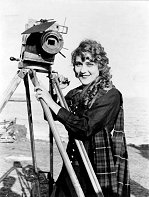
coming to California
In the old days, most movie studios were located east of the Mississippi River. Popular studio sites included New York, New Jersey, Chicago, and Florida.
In 1907, Selig was the first film company to shoot scenes in California. In 1910, the Biograph company began to spend winters in the Los Angeles area. Other companies arrived, and by 1911 they were building permanent studios near the pretty little village of Hollywood.
California quickly became a very desirable location for filmmakers. In addition to possessing the perfect climate for filming, it was also thousands of miles away from the east coast and the heavy-handed tactics of the Trust. By 1914, there were 52 movie companies in the Los Angeles area.
| |
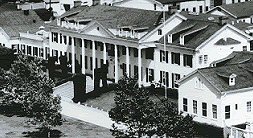
Ince Studio, built in 1918
the studios
In the 1910s, the movie companies were just as famous as the actors who appeared in their films....sometimes more so.

Click here to learn about the studios and their stars!
actors & the star system
Prior to the 1910s, movie actors were not identified in the film credits. The studios were afraid that if they identified their performers, they'd have to pay them more money. This wasn't really a problem, because most of the people appearing in films were stage actors who considered it beneath them to do movies.
Performers who appeared in many films were given generic names, such as The Vitagraph Girl and The Biograph Girl.
As the 1910s dawned, the public was beginning to recognize and request their favorite performers. The first two stars to benefit from this were Florence Lawrence ("The Biograph Girl") and Mary Pickford ("The Girl With The Curls").
In 1910, Carl Laemmle of the IMP company lured Florence Lawrence away from Biograph with an offer of more money and a promise that he'd reveal her name. When he delivered on his promise, she became the first movie star to be identified by name on posters and in the credits.
Mary Pickford became the next Biograph Girl. IMP also lured her away with promises of more money and fame. Other studios began to identify their stars, and the star system was born.
|
__________________________________________
|
|
|
RetroLisa
| ___________________________________________________________________ | __ | _____________________________ | _______ | Movie Technology
silent films
A silent film is a film that does not have a recorded soundtrack. The label is misleading, because many silent films were actually far from silent! In the 1910s, they were usually accompanied by sound effects, live music, live actors, phonograph recordings, or any combination thereof.
silent movie dialogue
Between 1908 and 1912, it was popular for movies to be accompanied by live actors who spoke the dialogue being mimed on the screen. Several movie distributors assembled small troupes of actors and sent them on the road to appear in theaters where their films were booked. The theaters either placed the actors on the stage in full view of the audience, or placed them behind the screen. These films were referred to as talking picture plays, talking pictures, and talkers. The shows went by various brand names, such as the Humanoscope, Dramagraph, and Humanovo.
silent movie music
In the early 1910s, the presence of musical accompaniment during a silent film varied from theater to theater. Some locations provided music during intermissions and illustrated songs, but not during the film itself. Other locations played music throughout the entire film. Still others limited their musical performances to certain scenes within each film. Public opinion was divided on the subject of movie music, and audiences were accustomed to all three approaches.
Depending on the size of the theater, music was provided by anything from a phonograph to a pianist to a full orchestra. In 1910, a new type of automatic piano known as a photoplayer was developed for movie theater use. This machine played music from piano rolls and contained extra instruments for percussion and sound effects. Sometimes the musicians were free to choose their own music, and sometimes the films came with sheet music and directions for when it should be played.
At this point, the sole function of film music was to comment on the action. This was done by using the most obvious, clichéd musical selections possible: fast-paced chase music for chase scenes, "The Light Cavalry Overture" for galloping horse scenes, and sinister piano music to mark the villain's entrance. Audiences with cultivated musical tastes found these uninspired choices to be quite frustrating.
By the late 1910s, the issue had sorted itself out. Musical accompaniment became the norm, and higher quality music was being chosen to not only comment on the action, but to create a mood or heighten an emotion.
| |
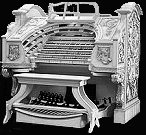

Click here to hear the
dastardly villain's theme music!
Silent Film Sound & Music Archive
The Fotoplayer Music Machine
|
sound films
synchronized sound
The first moving pictures were produced in 1888. From the very beginning, filmmakers experimented with ways to combine moving pictures and recorded sound. Between 1894 and 1913, they came up with a variety of gadgets that synchronized movies with cylinder and disc sound recordings.
These systems had names like the Vivaphone, Animatophone, and Projecting Kinetophone. The machines consisted of modified phonographs that played from the front of the theater, using a primitive compressed-air amplification system. Some devices were linked to the film by a dial or common shaft, while others were cranked by the projectionist in time to the movie.
Each system had its brief period of popularity, but the results were mediocre at best. Without electrical recording and amplification technology, these systems weren't practical for large theaters. By the mid 1910s, most of these processes had been abandoned.
sound-on-film
The sound-on-film process transforms sound waves into light rays, which are filmed on the edge of the picture. The basic technology was developed by Alexander Graham Bell in the 1880s. Eugene A. Lauste improved on it and patented his Photophone process in 1910. He made many sound films with this process between 1910 and 1914, but his work was halted by World War I.
color
Filmmakers tried many different ways to add color to their films. Their efforts fell into two categories: colorizing and natural color photography.
Colorized films were tinted by hand after the film was developed. Selected scenes could be colored in a highly detailed manner by applying dyes to each frame, or they could be washed in a single color to simulate a mood or time of day. The Pathecolor system used stencils to make the process less tedious. Hand-coloring was used sparingly, because the films were very difficult to produce.
The first experiments with natural color photography were conducted in the 1860s. During the 1900s and 1910s, a variety of rotating filter systems were developed that did a fairly good job of reproducing natural color. The Technicolor Corporation was founded in 1915 and introduced their first color system in 1917. The Kinemacolor and Prizma Color systems were also used during this decade.
film speed
There was no standard silent film speed. The best speed at which to show a silent movie is the speed at which it was filmed. Movie cameras were hand-cranked during the silent era, and the speed of filming varied from movie to movie, sometimes even from scene to scene! Films arrived at the theater with cue sheets specifying the speed at which the projectionist should show it.
film length
A reel of motion picture film lasts approximately 12 minutes. Prior to 1910, filmmakers were convinced that audiences wouldn't sit still for any film that lasted longer than one reel. During this time, a handful of longer films were released that could be shown either in one sitting or broken into installments. Most theaters chose to show them in installments.
By the early 1910s, many theaters were opting to show longer films in their entirety, and the studios responded by releasing longer films that were designed to be shown in one sitting. The success of these films proved that movie-goers had no problem watching movies that lasted two hours or more.
| |

The Development Of Color Films
The Correct Silent Film Speed
|
_________________________________________________
|
|
|
RetroLisa
| ________________________________________________ | ___ | ______________________________________________ | ________ | Movie Trends & Memories
a trip to the picture show
At most theaters, the show consisted of the main feature and one or two lesser reels. The lineup was usually different each day. Newspaper advertisements listed the schedule for the week, including the feature ("a 2-part Vitagraph drama"), the extra reels ("an Edison comedy and another good reel"), and any additional attractions ("a Burton Holmes Travelogue").
Admission generally ranged from 5 to 15 cents, although larger theaters showing epic blockbusters could charge as much as 25 cents. Afternoon matinees were the cheapest; evening shows and longer films were more expensive.
Audiences were extremely vocal in response to the action unfolding on the screen. They often entered the theater long after the movie had started, and stayed until the next showing reached the point at which they came in.
While reels were being changed, the pianist took the opportunity to lead everyone in a sing-along.
as good as it gets
Movie-going audiences didn't consider themselves deprived because their movies lacked soundtracks. Quite the contrary; movies were perfect just the way they were.
They had captivating stories, beautiful leading ladies, and handsome heroes. They had musical accompaniment, sound effects, and sometimes even spoken dialogue and color. They were easy to make, because movie crews could travel and film anywhere. All they needed was a movie camera and enough light to film by. There was no language barrier. Everyone could enjoy them, even recent immigrants who didn't speak English.
| |
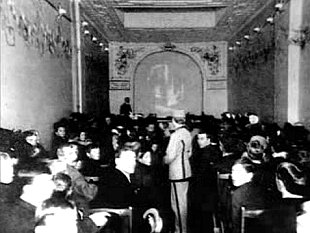
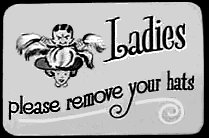
Slides were projected onto the screen while reels were being changed. Some featured advertisements for local businesses, while others were strictly informational.
|
popular genres & film series
cliffhanger serials
Serialized dramas had been a staple of magazines and newspapers for decades. In 1912, a whole new film genre was born when "McClure's Ladies World" decided to produce a serial film to accompany their latest magazine story.
During this decade, the hero of a cliffhanger serial was quite often female. Damsels in distress were certainly popular, but most serial ladies were feisty, intelligent, and quite capable of saving the day.
Cliffhanger serials became wildly popular with moviegoers. Before too long, the films themselves became the focal point, overshadowing the magazine stories they were designed to promote. Film production became the first priority, with novelized versions suitable for printing in local newspapers taking second place.
• The Perils Of Pauline
• What Happened To Mary?
• The Adventures Of Kathlyn
• The Masked Rider
• Trail Of The Octopus
• The Exploits Of Elaine
• Peg O' The Ring
• The Hazards Of Helen
• The Million Dollar Mystery
• The Ventures Of Marguerite
• The Trey O'Hearts
• A Lass Of The Lumberlands
• The Master Mystery
| |
comedy
• Gentleman Max
• Fatty & Mabel
• Keystone Kops
• Phunphilms/Lonesome Luke
• Sennett Bathing Beauties
• Universal Boy
• The Tramp
• Ham & Bud
western
• Tom Mix
• William S. Hart
• Broncho Billy
animation
• Krazy Kat
• Mutt & Jeff
• Farmer Al Falfa
• Dreamy Dud
• Out Of The Inkwell
• Happy Hooligan
• Judge Rummy
• Katzenjammer Kids
other genres
• Oz films
• North Woods dramas
• Titanic films
• boxing films
• Baby Marie Osborne
Film History Before 1920
Welcome To Silent Movies
The Serials: An Introduction
|
extra features
The earliest motion pictures were shown in vaudeville houses, where they were part of a longer variety bill. This practice was still alive and well in the 1910s. Larger theaters surrounded their films with singers, musicians, and variety acts. Nickelodeons and smaller theaters featured illustrated songs, newsreels, travelogues, and slide lectures.
newsreels
Actuality films captured real-life events on film. Twice a week, newsworthy tidbits were packaged into newsreels for release in theaters. The first newsreels were shown in Paris in 1908. In 1911, the "Pathe Weekly" was the first newsreel shown in the United States. At this early date, movie cameras rarely caught a breaking news story as it was happening. Much of the footage was recreated especially for the newsreel cameras.
• Selig-Tribune News Pictorial
• Vitagraph Monthly Of Current Events
• Hearst-Selig News Pictorial
• Pathe Weekly
• Universal Animated Weekly
• Hearst-International News Pictorial
• Hearst-Pathe News
• Ford Animated Weekly
• Warner's Features
• Gaumont Weekly
• Mutual Weekly
• Hearst-Vitagraph Weekly News Feature
• Pathe Semi-Weekly News Views
• Universal Screen Magazine
| |

illustrated songs
In smaller theaters, illustrated songs were a very popular and important part of the show. These tuneful interludes were the music videos of their day.
An illustrated song was performed by a pianist and vocalist, while a series of glass slides was projected onto the screen. In the photographs, models acted out the accompanying story. During the final chorus, the lyrics were displayed on the screen and everyone was invited to sing along. Music publishers distributed the slides to movie theaters to boost sales of sheet music.
The popularity of illustrated songs declined in the late 1910s. Theaters were beginning to eliminate many of their extra features to make room for longer films, and the easy availability of the phonograph created a record-buying public that had no need for sheet music or the multimedia presentations that promoted it.
Illustrated Songs
Hearing The Movies: Illustrating Song Slides
|
star filmographies
Mary Pickford
Buster Keaton
Roscoe "Fatty" Arbuckle
Lon Chaney
Douglas Fairbanks Sr.
Charlie Chaplin
Lillian Gish
| |

multimedia
1910s Movie Clips
|
__________________________________________
|
|
|
RetroLisa
| ___________________________________________________ | __ | __________________________________ | __________________ | Popular Films
1910
In Old California
The Life Of Moses
Aeroplane Flight & Wreck
Frankenstein
What The Daisy Said
The House With Closed Shutters
Wilful Peggy
The Stenographer's Friend
Uncle Tom's Cabin
The Johnson-Jeffries Fight
1911
Dante's Inferno
Fighting Blood
Enoch Arden
The Lonedale Operator
Winsor McCay & His Moving Comics
Her Crowning Glory
An Irish Honeymoon
A Tale Of Two Cities
1912
Oliver Twist
The Prisoner Of Zenda
Under Burning Skies
An Unseen Enemy
The Musketeers Of Pig Alley
Hoffmeyer's Legacy
The Girl & Her Trust
The County Fair
The New York Hat
From The Manger To The Cross
Quo Vadis
Queen Elizabeth
1913
Traffic In Souls
Fatty Joins The Force
The Bangville Police
The Battle At Elderbush Gulch
Mabel's Dramatic Career
The Speed Kings
1914
Tillie's Punctured Romance
The Squaw Man
The Last Indian Battles
Making A Living
Kid Auto Races At Venice
Gertie The Dinosaur
Mabel's Busy Day
Judith Of Bethulia
Laughing Gas
Uncle Tom's Cabin
The World, The Flesh & The Devil
Tess Of The Storm Country
1915
The Birth Of A Nation
Dr. Jeckyll & Mr. Hyde
A Jitney Elopement
Mabel & Fatty Viewing The World's Fair At San Francisco
The Tramp
Pool Sharks
Trilby
A Christmas Carol
The Battle Cry Of Peace
Ambrose's Nasty Temper
1916
Intolerance
Where Are My Children?
The Melting Pot
Jackstraws
Temptation
The Vagabond
Carew & Son
20,000 Leagues Under The Sea
The Rink
Fatty & Mabel Adrift
Krazy Kat Goes A-Wooing
His Bitter Pill
The Battle Of The Somme
Daughter Of The Gods
Sherlock Holmes
1917
Bucking Broadway
The Immigrant
Easy Street
The Butcher Boy
Straight Shooting
Coney Island
Poor Little Rich Girl
A Clever Dummy
Rebecca Of Sunnybrook Farm
Cleopatra
Nan Of Music Mountain
1918
Tarzan Of The Apes
Stella Maris
A Dog's Life
Shoulder Arms
Amarilly Of Clothes-Line Alley
Hearts Of The World
Out West
Moonshine
The City Slicker
1919
Blind Husbands
Broken Blossoms
True Heart Susie
A Day's Pleasure
South
Sunnyside
Back Stage
Ask Father
Opium
A Romance Of Happy Valley
The Miracle Man
| |
|
_________________________________________________
|
|
|
RetroLisa
| ___________________________________________________________________ | __ | _____________________________ | _______ | On Stage
Still to come!
| | |
_________________________________________________
|
|
|
